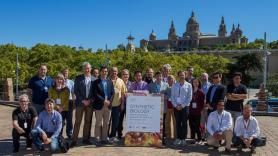1. What is synthetic biology
“The goal of synthetic biology is to design and redesign living organisms with precision,” sums up Jordi García-Ojalvo, director of the Dynamical Systems Biology Laboratory at Pompeu Fabra University and scientific leader of this B·Debate. “It’s genetic engineering 2.0 because it isn’t just putting parts together: it uses the tools of physics, engineering and mathematics taking into account how they all interact. This way, it seeks to reprogram organisms to do things they don’t naturally do, which could be beneficial to humans.”
For Ricard Solé, director of the Complex Systems Laboratory at Pompeu Fabra University, “synthetic biology is still in its adolescence, but is picking up speed. We can now engineer life.”
However synthetic biology isn’t free of controversy among scientists, especially engineers and biologists In the words of Wendell Lim, professor of Cellular and Molecular Pharmacology at the University of California, “for biologists, genetic modifications are a way to understand nature, not an end in and of themselves, and they wonder why engineers don’t appreciate nature’s complex, precise designs. Engineers are also perplexed: why don’t biologists appreciate it when we replace such a complex system with a much simpler, more predictable alternative?”.
In general, engineers look for “standards”, parts that carry out a function and can do so when introduced into any organism. Biologists disagree, as they believe life is too complex to be simplified and that the genetic background of any organism will always affect how the parts behave. This is the opinion of Manel Porcar, director of the Biotechnology and Synthetic Biology laboratory at the University of Valencia: “In biology, the number of components is relatively small, but the number of interactions is huge. Just he opposite of what happens in traditional engineering,” he explains.
There are two other broad traits that separate biology from pure engineering. One is noise: cells change their behavior over time and no cell is ever exactly the same as its neighbor. This makes it complicated to find the precision and clarity engineers seek. Another is evolution. Living beings are the product of millions of years of trial and error. For García-Ojalvo, synthetic biology mustn’t lose sight of this, it has to “use what we know to improve design and remember that any organism we design will also tend towards evolution.”



